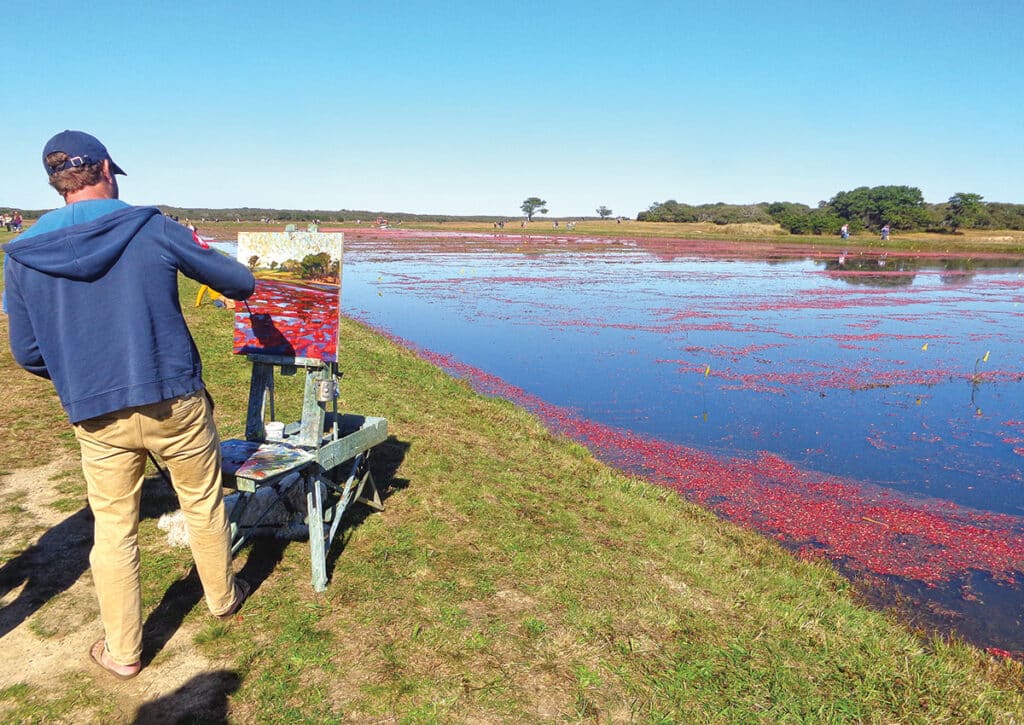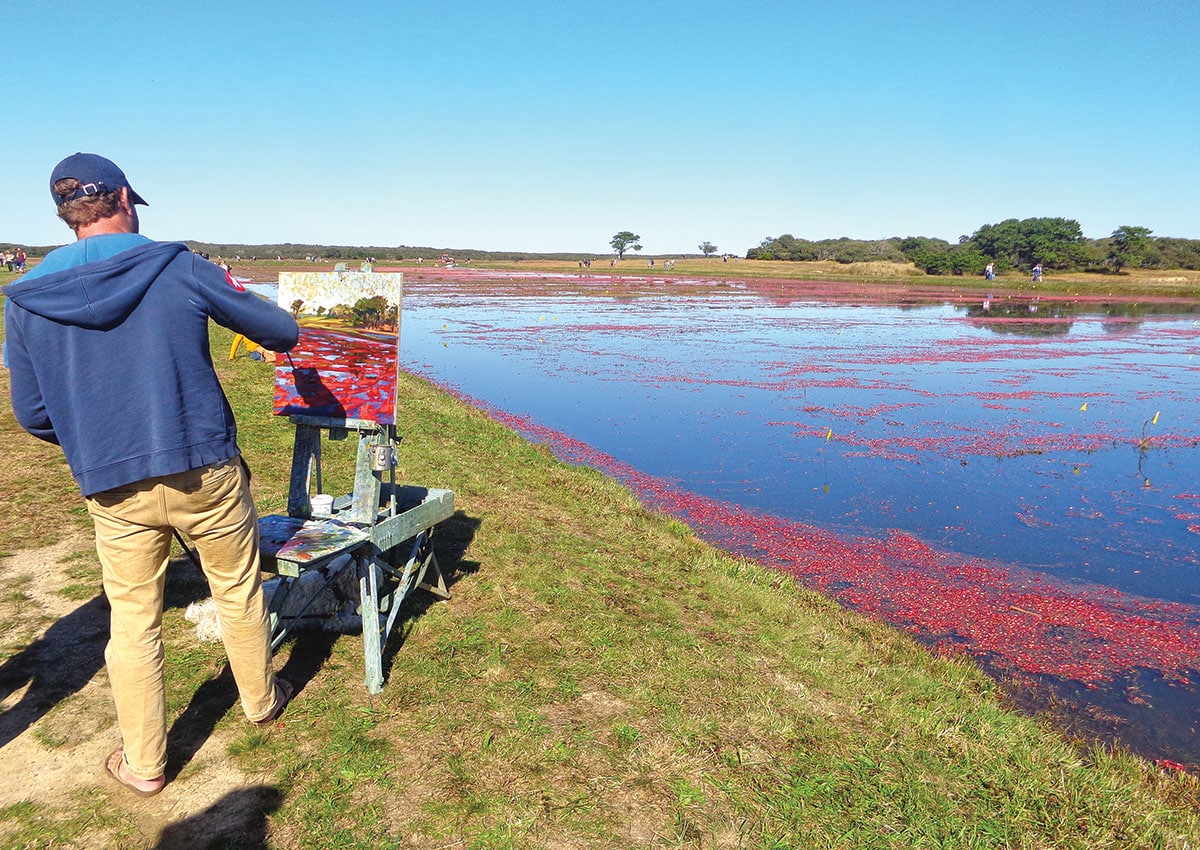by C. Oscar Olson
Though most of the season’s harvests have come to a close, one of our region’s most prized pieces of produce is just about to float to the surface. Before long, the bogs will be flooded for wet harvesting and machinery will be rolled out for dry harvesting, and that precious red fruit will begin its journey to your holiday dinners.
For more than 150 years, the cranberry harvest has been an important aspect of both the heritage and future of agriculture on Nantucket. While many farms of all scales and scopes thrive, the Milestone Cranberry Bog is not only the oldest but also the largest continually operated farm on the island.

Cranberry farming got a foothold on Nantucket in 1857 at this very location off the middle of Milestone Road. Not long ago, the Milestone Bog had 234 acres under active cultivation, making it the single largest contiguous bog on Earth. Since then, with the advent of improved irrigation techniques, the bog has been broken up into a series of smaller and more efficient growing sites.
Ownership of the bog changed several times for the first 100 years of its existence, but that all changed in 1968 when it was purchased by Roy Larsen, Walter Beinecke, Jr., and Arthur Dean. The three men donated it to the Nantucket Conservation Foundation with the expectation that it be an income producer for the nonprofit organization. Stewards of nearly 1/3 of the land on Nantucket, it is the mission of the NCF to assist in the preservation of Nantucket’s character by permanently conserving, maintaining, and managing natural areas and habitats and to encourage an appreciation of and interest in the Island’s natural resources.
In 1951, before the acquisition of the land by the NCF, native Nantucketer Tom Larrabee was hired as a field hand by the bog’s former owners. Though the job was unforgiving, Tom was taken by the area’s isolated beauty. He loved the land and for 15 years he put endless hours into studying the unique challenges that come with farming so far out to sea. The Foundation named him bog manager in 1979, and in 2009 he and his son Tom Jr. celebrated his 50th anniversary on the farm. Today the bog is proudly managed by the 3rd generation of Larrabees with Tom’s grandson Nick at the helm.
While harvesting cranberries is the ultimate goal of the Milestone property, the boundaries sprawl beyond the bog itself. Only 1/3 of the land is utilized for farming, while the rest of the rolling hills, grass lands, and fresh water ponds of the Middle Moors are left open for rich populations of flora and fauna.
Today, Milestone consists of 24 individual bog totaling 195 acres under active cranberry cultivation. Several varieties of cranberries are getting ready to take the plunge, ripening at different points in the season enabling an easier, spread out harvest. Though they yield varies from year to year, it is common to see as much as 2 million pounds of cranberries when the work is finished. Most (95%) of cranberries are harvested wet and go on to be frozen, dried, or processed into sauces and relishes. The rest are dry harvested and sold fresh. You can find genuine Nantucket cranberries at NCF offices during the harvest season.
While cranberry cultivation is common on both sides of the Bourne Bridge, Milestone Bog has set itself apart from the rest of the competition. They are branded as being an exclusively organic farm, making the Nantucket Conservation Foundation the largest organic cranberry grower in the United States.
Before 2019, Nantucket was home to one other working cranberry bog. Located approximately six miles up Polpis Road, Windswept Cranberry Bog is now in the process of being restored to a fully functioning wetland. “It’s going to be a long process,” says NCF’s Director of Marketing and Communications Grace Hull. “There’s a lot of testing and surveying that still needs to be done. It’s not something that can happen overnight.” The decision was made not only to preserve to health of the harbor, but also came due to recent challenges in the American market. An influx of Canadian cranberries has driven the price down overall, and the bog was no longer economically viable to operate.
In order to pick the fresh fruit, the vines must be completely dry. Even a slight shower the night before, heavy dew, or damp conditions from fog can be enough to delay harvest until conditions improve. As if 2020 hasn’t brought its fair share, these factors can provide more than enough challenges to growers.
Dry harvesting involves lawnmower-like mechanical pickers that comb through the vines and convey the berries into a bag or box attached to the rear of the machine. Wet harvesting, the method used most often, is truly something to behold. The night before the harvest, bogs are flooded with up to 18 inches of water. Next, growers use a water reel, aptly referred to as an “egg beater,” to the churn the submerged plants and loosen the berries from the vine, allowing the air pockets within each fruit to float them to the surface. From there, the berries are corralled into a swirling soup of pinks and reds, loaded onto trucks and are soon sent on their way to processing.
For hundreds of years, the cranberry has been prized for its reputation as a superfood. Before the settlers arrived on Nantucket, the island’s indigenous people enjoyed the annual harvest of sasumuneash—wild cranberries—for thousands of years. Berries were consumed both fresh and dried, while some were used to make pemmican, a shelf-stable mixture of fruit, dried meat, and animal fat. The fruit was used commonly in healing rituals to combat fever, injury, and even seasickness.
When Europeans began exploring and settling New England, they were not surprised to see the red berries thriving in the peat fields and swamps along the coast. They were familiar with European cranberry varieties, which were common in such environments in parts of England. The English had many names for the fruit, but “craneberries” was the most common due to the shape of cranberry flower and its resemblance to the head of a Sandhill crane.
Today, we know well the health benefits of consuming cranberries. The terrifically tart morsels are loaded with vitamin C, with an eight ounce glass of cranberry juice packing over 150% of your recommended daily allowance. There are also bacteria blocking benefits that ward off UTIs and ulcers, and these benefits are available in an array of cranberry products. Cranberries also contain proanthocyanidins, or PACs, which are linked to reducing infection, promoting heart health, decreasing inflammation, and supporting digestive health.
In previous years, the harvest on Nantucket has been celebrated with the annual Nantucket Cranberry Festival: a day of family fun held Columbus Day weekend at the Milestone Bog. Though pandemic restrictions have forced the organization to cancel one of the island’s favorite and final hurrahs of the year, there are still ways to enjoy the 17th year of this Nantucket tradition.
The NCF is committed to continue their education and outreach around the cranberry harvest and its history to the community. “Our Cranberry Festival is listed as one of those fall events you simply must attend, and we are going to miss it very much this year,” says Grace Hull. “It’s a great opportunity to showcase the property and how everything works. Instead, we’re planning a number of walking tours.”
Over a period of two weeks in early to mid October, small groups will be shown guided tours of the Milestone Bog twice a day. The tours will be led by NCF’s Neil Foley in conjunction with bog manager Nick Larrabee. Keep an eye on their website NantucketConservation.org and watch their social media pages @ackconservation for more information. “We still want to get people out there and learn about the bogs, and we’re hoping to be able to sell some dry picked berries as well.” In addition to the walking tours, NCF will have a table at the Sustainable Farmer’s Market on Saturday, October 10. “Come by for fresh cranberries and some Nantucket Conservation swag!” Hull remarks.
As the official fruit of the state of Massachusetts, cranberries have deep roots in what defines this land we love. Be sure to enjoy the fruits of the Foundation’s labor, and with them all the good things the arrival of autumn has to offer.



